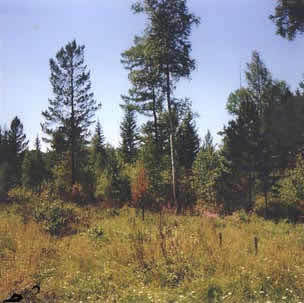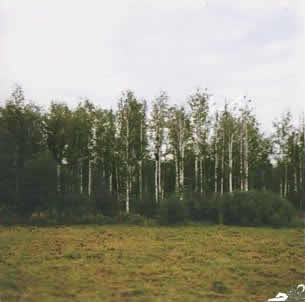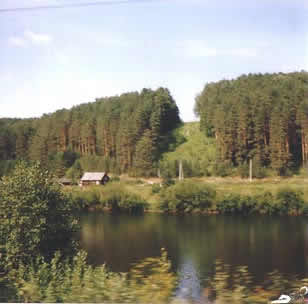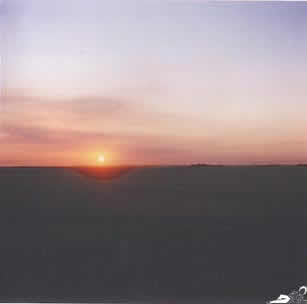Siberia
The conquest of Siberia started during the reign of Ivan IV. (the Terrible). About 1581 a large group of Don Cossacks set out across to Ural to submit the vast areas on the other side of the Ural, then known by the name of Jurga, to Russian rule. They were pursued to do so by the members of a rich merchant family, the Stroganovs, and counted with the approval of the tsar.
| The woods in Siberia have not been planted or tended: They just grow, burn down and re-emerge almost without human interference |  |
The Cossacks were the descendants of serfs who had fled from the 14th century on from their native soil in the Russian grand duchies and the Polish-Lithuanian kingdom to the styeppe regions bordering the Black and Caspian Seas. They often called themselves proudly "free Cossacks" in order to underline that they were not subjects of any master. They established a loose system of settlements, called "khutors" and, if bigger, "stanitsas" and lived predominantly on the booty of their armed raids into neighboring territories. These neighboring territories were mostly under Tartar rule, but the cossacks did not refrain to plunder Russian settlements, too, if they felt like it. They were not reluctant, either, to step temporarily as mercenaries into the service of Russian, Polish or Tartar rulers.
As the grand dukes of Moscow started to re-unite the Russian lands the Cossacks more and more moved into the center of their attention. They constituted a territory and population both attractive and dangerous to the Russian rulers. On the one hand, they had extended the Russian-populated territory to the South and constituted a defense against non-Russian possible invaders and raiders from the South. On the other hand, they were not subjected to the Russian rulers and by their belligerence and independence constituted a constant threat for the Moscovite empire-building.
By the time of Ivan IV this contradiction had reached a climax and Ivan was seriously thinking about waging war on the Cossacks in order to pacify them and integrate them into his empire.
Furthermore, he had to think about the future of the Trans-Uralian regions. It was known that they were sparsely populated areas without any state-like powers. As a power vacuum, they might attract other emerging powers who would then establish themselves there and supply Russia with an unwelcome and threatening neighbourhood.
There were some candidates for such an enterprise. The Tartars had been defeated by Ivan in Kazan and Astrakhan, but some Tartar khans were considering to establish themselves on the other side of the Ural, gaining strength and attempting a re-conquest of their lost realms.
As trade by sea to Western Europe was established in the 16th century through the port of Arkhangelsk, then called Kholmogory, the interest of western rulers in the Arctic Sea and Siberia grew. English, Dutch and German merchants and adventurers had tried to find a way to Siberia by land or by sea, so far in vain. Siberia was interesting to those people for getting hold on the valuable Russian fur trade and finding an overland route to China and India. Some western rulers certainly also had in mind to prevent the Moscovite empire from further expansion and would have liked to control it from the east.
| The birch woods are a familiar sight in Russia and especially in Siberia, as the birch is rather resistant to the extreme cold. |  |
The Stroganovs were wealthy and powerful merchants based in the region of the Western Ural, near to the river Kama. Apart from trade with everything tradeable, first of all furs, they were engaged in salt production, too. Their anchestors had come Novgorod and established themselves as salt manufacturers farther northeast, on the Vichegda river. Some decades later a vast area on the banks of the river Kama had been conceded to the brothers Grigorij and Jakov Stroganov, and later tsar Ivan IV also gave them the permission to conquer Siberia, generously donating lands to them that had never belonged to Russia.
They entered in negotiations with the Cossacks led by Yermak Timofeyevich and reached an accord. To the Cossacks the conquest of the lands on the other side of the Ural – then still called the "Stone Belt" – seemed an interesting and rewarding enterprise, furthermore it gained them the favour of the tsar and spared them from repressions.
The Stroganovs wanted to secure their territory on the Kama against raids from Siberia and to monopolize the Siberian fur trade. They were ready to invest.
Yermak himself died in 1585 in a battle against Tartar forces. But his men pressed on, closely followed by greedy merchants, and later supported by all kinds of regular or less regular fighters in the service of the tsars or contemporary businessmen. The Cossacks now became the spine of the Russian armed forces, a role they preserved till the end of Tsarist rule.
Most mayor towns in Siberia were originally founded as fortresses or Cossack garrisons. Tobolsk was founded in 1590, Tomsk in 1604, Krasnoyarsk in 1628, Irkutsk in 1686. Novosibirsk, Russia’s third largest city, came into existence later, about 1892, as the Transsiberian Railroad was built.
 |
Siberia before the conquest was populated by various tribes and people speaking languages of the Finn-Ugor, Turk and Mongolian families and practicing nature religions which are nowadays referred to as shamanism. In southern parts of Siberia Islam had spread to a certain extent. The descendants of these peoples are still living in Siberia. Though in Tsarist times there were attempts to christianize them many of them have preserved their old beliefs and practics. (The most famous Siberian shaman was Rasputin who made a big career in Petersburg, but due to his untimely and violent death could only enjoy it for a short time.)
The Russian settlers consisted of the Cossacks, merchants, peasants in search for fertile soil, and "starovery", Old Believers: In the 17th century the Russian church decided to carry out a series of reforms. The most important innovation was the introduction of Trinity. Those orthodox believers who were not willing to convert to this "new" faith were obliged to leave the European part of Russia and moved to Siberia in large numbers.
Tsarist Russia employed banishment on a large scale. Most of the banished were political prisoners, people who for different reasons had made themselves unpopular with the tsar and his advisers. They were either condemned to forced labour in mines or manufactures in Siberia, or they were confined to a certain place that they were forbidden to leave. An especially large number of banished were Poles, as the Polish people constantly revolted against Russian dominion that had been imposed in a part of Poland in consequence of the Polish Partitions. For this reason Polish names are quite frequent in Siberia and most larger towns have a catholic church.
The tradition if banishment survived the monarchy and was developed further in Soviet Union. After the revolution the political enemies of the Bolsheviki who were not killed or fled ended up in Siberia. So the Siberian population was enriched by Social Revolutionaries, Mensheviks, Anarchists, furthermore "borgeouis elements", merchants, officers of the tsarist army or people who had collaborated with the invasion troops of the White Army, or at least were suspected of having done so. The next big wave of settlers reached Siberia in 1930 as the Kulaks were deported.
"Kulak", in Russian fist, was a word to call the wealther peasants in the village. In the 18th century the Kulaks were the descendants of the former feudal owners who had been compensated generously for the loss of their serfs by getting much of the arable land, the pastures and the woods and who thus were advantaged in comparison to the others who had to work for them. Later, as a consequence of the agrarian reforms at the beginning of the 20th century a new generation of Kulaks emerged, in addition to the traditional ones: Those who profited from the reforms and surpassed the other peasants in the village.
To understand the notion thoroughly it is important to bear in mind that not the absolute value of one’s property was estimated, but the Kulak was wealthy in comparison to the others in the village. Who was considered rich in one place might have been poor in another. And: there was often a trace of envy in it.
During the October Revolution the word "Kulak" was used for every peasant who opposed the Bolsheviks. It became a notion for anti-bolshevik elements in the village. Still, after Soviet power was established it seemed that the word would disappear and individual prosperity would be tolerated among the peasants. Lenin had given land to every peasant in his "Decree on Land" in 1917. The New Economic Politics were introduced in 1921 and people throughout the country were encouraged to "enrich themselves". When in 1928 a catastrophic shortage of grain emerged, the party leadership looked for scapegoats and – surprise, surprise – found out that the Kulaks were still there and responsible for the lack of bread in Soviet Union. The party decided to introduce collectivization in order to ensure the future supply with grain and to liquidate private property on land. Everybody who resisted was a Kulak.
Between 1929 and 1934 millions of people (the estimations go from 2 to 10 millions, and there are no official figures) were deported to Siberia as Kulaks, many of whom perished immediately in consequence of the conditions of deportation and harsh treatment in their new destinations.
So far the Kulaks. After the assassination of Kirov in 1934 the years of the Big Terror started and Siberia was provided with a lot of new inhabitants, many of them members of the Communist Party, and their relatives. In and after World War II came the prisoners of war. This meant not only the prisoners taken by the Red Army, but also many Soviet soldiers who returned from German captivity and were considered traitors who had not fought bravely, and were also sent to Siberia.
 |
All these practices of banishment and deportation and labour camps are not only outsprings of cruelty and statal terror, but also have to do with the special climate and geography of Siberia. Siberia is rich in resources, but it takes people to unearth them, to work the land, to transport the goods and to create the necessary infrastructure for that. On the other hand, the living conditions and the climate are hard to bear and it has always been difficult to persuade people to settle in Siberia, which resulted in a constant shortage of labour. So the Russian and Soviet rules decided to kill two birds with one stone: To get rid of undesireable elements and to develop and exploit Siberia.
Many of the inhabitants of Siberia therefore are descendants of people who did not end up in this part of the world voluntarily. In consequence the Siberians in general are mistrustful towards their government and symphatetic towards the persecuted, and they have a certain conscience of their freedom: After all, they are already in Siberia, if the authorities want to punish them, where would they send them from there?
In Siberia the winters are very cold, and in the south the summers can be very hot, and extremely mosquito-plagued. Everything in Siberia is large: The distances are enormous, the woods are dense, the treeless landscapes are infinite. It is an area of unlimited possibilities, in good and bad.
The Altai, Part One: Lake Teletskoye and the Chulyshman-valley